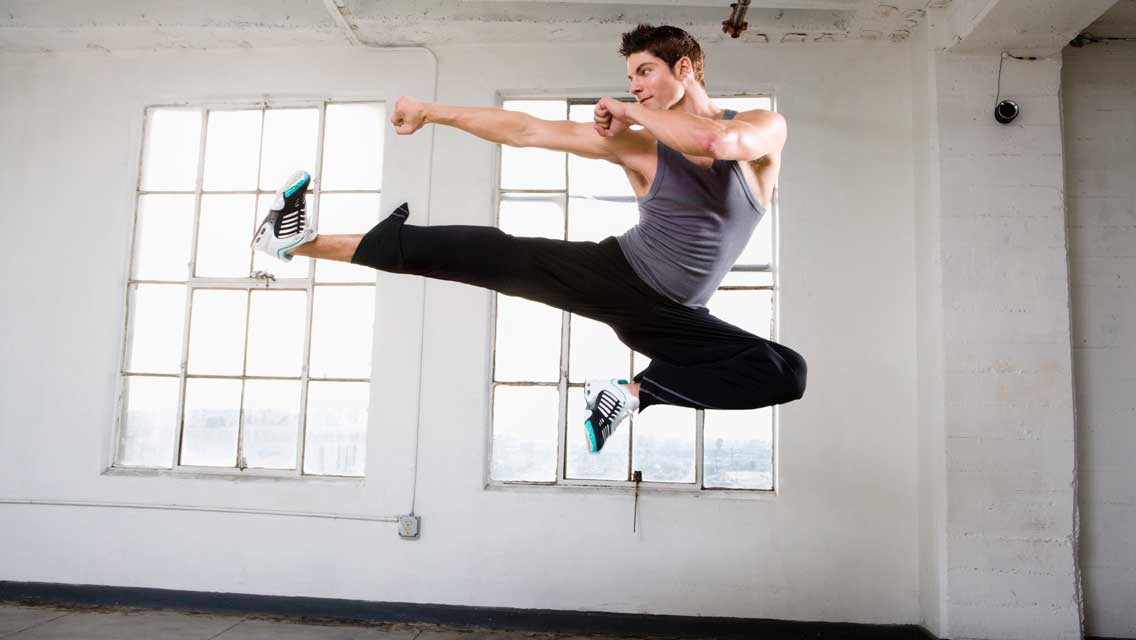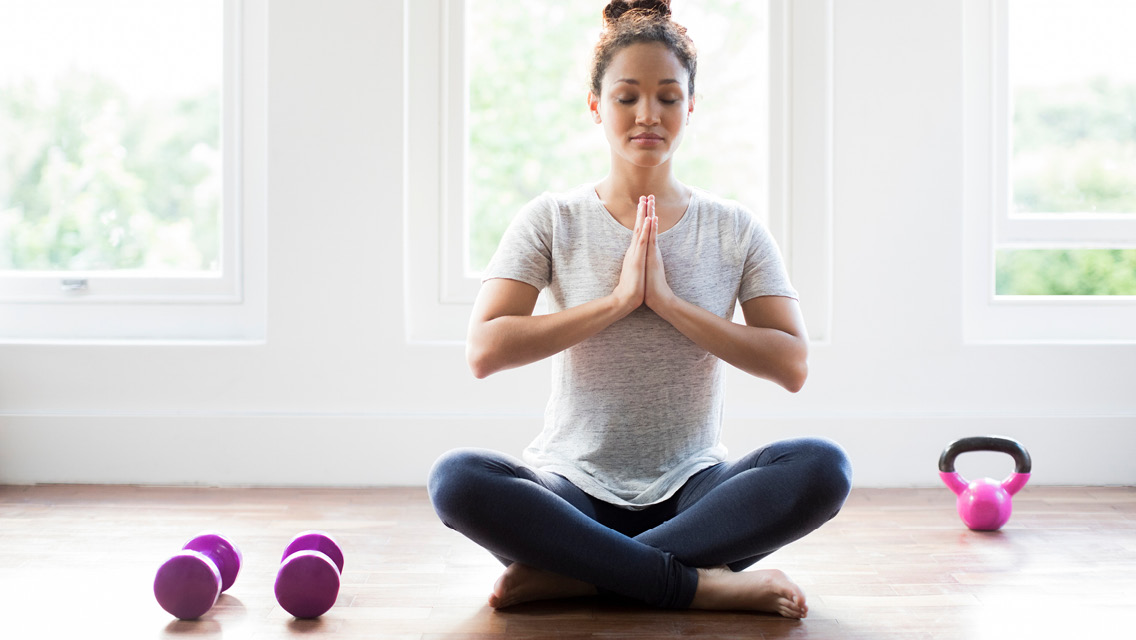A martial arts class in session is hard to ignore. Strolling past, you’re sure to hear the exclamations of the students (“kee-yah!”) or witness their energetic tussles — equal parts combat and ritual movement. If you’ve never taken a class yourself, it’s probably because you assume it’s too physical, too competitive or too steeped in an Eastern philosophy you don’t really understand. Besides, you don’t think it’s important to learn how to defend yourself, and you don’t have the desire to spar with anyone else.
These are all common misconceptions about martial arts, says Rob Colasanti, president of the National Association of Professional Martial Artists. “Beginners’ classes aren’t physically demanding — you get in shape as you go along — and you often don’t do any sparring for several months,” he explains. “People sometimes think martial arts are violent because of what they see in the movies and mixed martial arts matches on TV, but that’s completely off. Martial arts lessons are more about developing the confidence that helps you avoid a fight.” And most instructors, he adds, don’t emphasize Asian philosophy.
“I Martial arts lessons are more about developing the confidence that helps you avoid a fight.”
Martial arts classes also offer a great workout that develops balance, strength and overall fitness in a way that’s fun and different from other group exercise classes. Not to mention how they cultivate inner strength — qualities like confidence and self-discipline that make martial arts so much more than mere exercise. And if you also happen to learn how to fend off a potential attacker, that’s even better.
“Many people get involved in martial arts for fitness reasons instead of self-defense concerns,” says Jennifer Lawler, whose 15 martial arts books include Martial Arts for Dummies and Tae Kwon Do for Women. She suggests checking out different schools, styles and instructors — most will allow you to observe or take a free class — until you find the right fit. “If you feel comfortable and supported by the instructor, you’re more likely to succeed and stay with it,” she explains.
Which style should you try first? The following descriptions of America’s most popular martial arts should help you find the best fit for yourself.
Tae Kwon Do
This ancient Korean martial art and Olympic sport (also spelled “taekwondo”) has become wildly popular worldwide — especially in America — since eighth-degree black belt Chuck Norris popularized it in movies and the TV series Walker, Texas Ranger. Kicks are the dominant tae kwon do move, but jumps, spins, punches, blocks and parries (deflecting a move) add to the fun. You’ll first learn to kick from standing positions; “flying” kicks come later. Classes will challenge your stamina, strength (you might be asked to break some boards) and flexibility — as well as mental strength and equanimity. Instructors impart the Five Tenets (courtesy, integrity, perseverance, self-control and indomitable spirit) during every class.
Appeal Factor: Easier learning curve than most martial arts, it’s an excellent full-body workout.
Best For: People who are tall have an advantage because of the emphasis on kicks. Suits those who want to become quicker and more flexible and who want a strong emphasis on getting a great workout.
Karate
Karate has become so well known in recent years that it’s almost synonymous with martial arts. But this import from the Japanese island of Okinawa is distinct from other styles because of its emphasis on strength and power, characterized by self-defense tactics like “knife hands,” elbow strikes and heel strikes. Still, there’s enough variety in classes that you can also improve cardio fitness, balance and flexibility. Some instructors spend a lot of time on the spiritual aspects of traditional karate, but in most classes you’ll focus on the more practical mental skills of concentration and self-discipline.
Appeal Factor: Karate tends to develop physical and mental strength better than most martial arts.
Best For: Those interested in improving their strength and power.
Brazilian Jiu-Jitsu
Not to be confused with Japanese jujitsu, Brazilian jiu-jitsu draws more of its techniques from judo (see below) than its Japanese namesake. In fact, it mixes techniques from a variety of styles, which gives you a better chance of defending yourself — whether in a real-world attack or a competitive match — than a less varied style does. This is why Brazilian jiu-jitsu is the favored style of mixed martial arts fighters and military hand-to-hand combat training. You’ll learn striking and kicking skills, but the main emphasis of this style is on grappling (similar to wrestling). You’re trained to take your opponent down to the floor with striking and kicking techniques, and then to prevail with grappling or “ground fighting” skills.
Appeal Factor: Philosophy instruction is not a big part of these classes at most U.S. schools, so there’s less listening time and more workout time.
Best For: People who like the emphasis on grappling rather than stand-up skills.
Tai Chi
There is a high-speed, self-defense version of the Chinese martial art of tai chi, but the vast majority of the hundreds of millions of people who practice it worldwide do it in super-slow-mo. And no wonder. The hypnotic circular movements involve little or no impact on the joints or the rest of the body, making it an excellent choice for people of all ages and abilities. Besides being offered at martial arts schools, it’s taught at many community centers and health clubs. Classes are more likely to involve mind-body training, especially meditation and relaxed breathing, than other disciplines. (For more on tai chi, see “Ancient Practice, Modern Medicine”.)
Appeal Factor: Tai chi has been shown to lower blood pressure and reduce stress; you can do it anywhere, alone or in a class; and there’s no uniform, so loose-fitting clothing is all you need to wear.
Best For: People who wish to balance out a busy, stressful schedule with a low-impact, stress-reducing activity they can do anytime, anywhere, once they learn the “forms.”
Kung Fu
The ancient Chinese martial art popularized by Bruce Lee, kung fu emphasizes a variety of stances, footwork, kicking, blocking, evading, and hand and elbow strikes. “Kung fu” means “human effort” for a reason: Its demands of balance, speed and overall fitness are substantial, so it’s a good workout. When you contact schools, ask which styles of kung fu they teach. The Northern style emphasizes kicking and footwork — best for tall, long-legged students — while the Southern style emphasizes punching — better for shorter students. Besides Northern or Southern, kung fu styles are classified as either “external” (focused on strength and offense) or “internal” (focused on concentration and defense).
Appeal Factor: Once you’ve mastered the basic forms, you can move on relatively quickly to performing them with various weapons, such as broadswords.
Best For: People with the patience to master a difficult style, because you need at least eight months to learn basic skills.
Kickboxing
America’s most popular kickboxing classes go by names like cardio kickboxing, fitness kickboxing and Tae Bo. They’re offered by many health clubs and usually consist of a high-energy workout (fueled by suitably high-energy music) that might include jumping rope, kicking bags, punching bags and shadowboxing. Most of these classes don’t include sparring; the idea is that you train like a kickboxer, but without having to take (or give) a punch. Few other martial arts classes, if any, provide such a strenuous, full-body workout, and many students use kickboxing as a springboard to more complex martial arts. (Muay Thai Kickboxing, by contrast, is a centuries-old competitive sport taught at martial arts schools. It’s physically demanding and includes significant physical contact.)
Appeal Factor: Kickboxing offers a great workout, and there’s no uniform to buy.
Best For: People interested in shaking up their fitness routine with the excellent full-body workout that martial arts provides, but without getting hit or kicked.
Martial Arts for Kids
Martial arts instruction can be a powerful, positive force in the lives of children because it instills self-discipline; develops their physical strength, coordination and overall fitness; and enhances their self-esteem and social skills. The tools of concentration they’ll learn will lengthen their attention spans, too. And they can start as young as age 3.
The most popular martial arts styles among kids starting out are tae kwon do and karate. Classes just for kids are easy to find in those two styles, while styles like tai chi and kickboxing are mostly geared to adults. But more important than the discipline’s style is the instructor’s style. Therefore, it’s important to observe a class (or two) with your child at a martial arts school before signing up. Wait until you’ve found an instructor whose teaching style matches your child’s goals and temperament. Usually the best schools have been around for a while, and they should require use of a full set of safety equipment (headgear, mouth guard, chest protector, sparring gloves, shin guards, foot protection, and cup or other support for boys) once sparring begins.
11 More Martial Arts
There are dozens of martial-arts styles – hundreds if you count the variations of each style – that are taught in the United States, with origins in every part of the world. Besides the six main styles outlined in our article, here are 11 more that are taught widely.
- Qigong (also called Chi Kung), like tai chi, consists of slow-motion movements and breathing exercises meant to release negative energy. It’s often taught in conjunction with tai chi or kung fu.
- Jujutsu — also spelled “jujitsu,” but quite different than Brazilian jiu-jitsu — is an ancient Japanese martial art favored by samurai warriors that involves throwing, grappling and ground-fighting moves like “wrist-flex takedowns” and “hip throws.”
- Judo, which draws techniques from Japanese jujutsu, is a high-intensity Olympic sport that employs defensive moves and explosive pushes, rolls and tumbles.
- Aikido is an advanced, purely defensive Japanese martial art that uses many jujutsu techniques and more difficult throwing techniques, supplemented by instruction in personal development and a rich philosophy rooted in nonviolence.
- Mixed Martial Arts is big entertainment — the Ultimate Fighting Championship is a $1 billion enterprise — that’s inspired many instructors to begin teaching a version of this blend of boxing, wrestling, Muay Thai kickboxing, Brazilian jiu-jitsu and conditioning, but with more safety equipment worn.
- Krav Maga, created for the Israeli Defense Forces, is an up-and-coming martial art that fuses Asian martial arts and hand-to-hand military combat training.
- Boxing workouts will get you in great shape if you’re willing to tap into your inner Muhammad or Laila Ali, and not all boxing classes involve sparring.
- Hapkido, a hybrid of Korea’s tae kwon do and Japan’s aiki-jitsu, emphasizes grappling, throwing and restraining your opponent.
- Kenpo (also called Kempo) has similarities to karate, but features rapid, slapping-type strikes.
- Filipino Martial Arts — notably Escrima, Arnis and Kali — are disciplines that emphasize stick fighting and are popular in many U.S. cities.
- Capoeira is an Afro-Brazilian discipline often described as a blend of martial arts and dance, or martial arts set to music.
This article originally appeared as “Kick It Up a Notch” in the October 2009 issue of Experience Life.




This Post Has 0 Comments